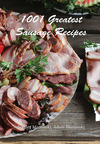Meats and Sausages
Brine for Pickles
Brine for pickles is made with salt and water. Too little salt lets undesirable bacteria grow rapidly. Too much salt slows down the fermentation process. The strength of the brine largely determines the taste of a pickle. Pickles made with lower salt brines result in better quality and contain less salt, a fact which is of much importance for people on a low salt diet. Cucumbers placed in low salt brines may exhibit a softer texture due to the enzymes which came from the cucumber itself, or yeasts and molds. Cucumbers placed in higher salt brines around 10% will develop a harder texture, but will be much saltier. Very salty brines (over 10%, 40 SAL) can prevent fermentation. As a general rule, fermentation takes place well in a brine of about 20° SAL (3/4 cup salt per gallon of water) and most people use this combination.
Typical brines:
| % salt | °Sal | Salt per gallon of water | Salt Weight | Remarks |
|---|---|---|---|---|
| 3.5 | 14 | 1/2 cup | 144 g | half sour, fermentation accomplished in one week, not suitable for canning, keep refrigerated. |
| 4 | 18 | 2/3 cup | 192 g | half sour, not suitable for canning, keep refrigerated. |
| 5 | 21 | 3/4 cup | 216 g | sour, pickles fermented in 5% brine usually contain around 3% salt in a finished product, can be canned. |
| 7-8 | 26-30 | 1 cup | 288 g | very salty, long fermentation (6-8 weeks), Lactobacillus plantarum is the dominant bacteria strain, can be canned. |
Seawater contains approximately 3.6% of salt which corresponds to 14 degrees salometer. Higher salt concentrations than >10% (>40° SAL) are not recommended as:
Such high salt percentage inhibits lactic acid bacteria which may not ferment at all. This will result in very salty pickles which will have to be soaked in clean water before use. More bloaters (hollow-center pickles) may be produced. At 15% salt , 60° SAL, lactic bacteria cannot function, and no fermentation will take place.
















